Cataphracts of antiquity. Emergence
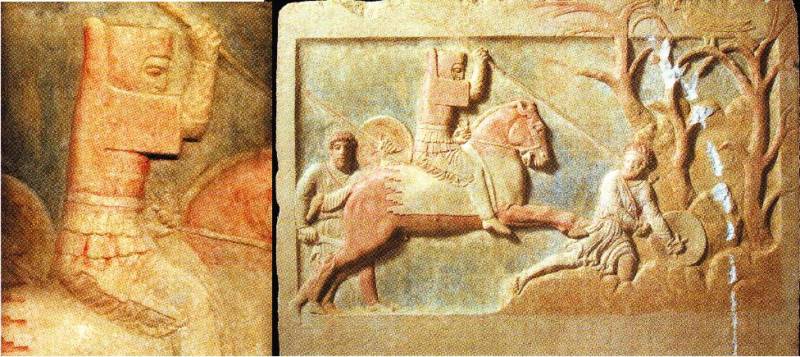
Persian horseman. IV century BC e. Relief on a tomb from Chan, Turkey. The rider has a helmet, a carapace with a standing collar and pterygs, leggings and a relatively short spear. The horse is protected by a bib, possibly leather. Reproduced by Nurten Sevinç, Reyhan Körpe, Musa Tombuletc. (2001). A new painted Graeco-Persian sarcophagus from Çan.
Entry
Why write about something that has been written a hundred times before you? After all, the topic of ancient cataphracts cannot be called insufficiently illuminated in historical literature. It would seem that the number of articles and books, one way or another touching on the problem, is difficult even to count, the topic is illuminated from all conceivable and inconceivable angles within all sorts of contexts.
Nevertheless, it is practically impossible to find any complete work on cataphracts as a whole. Many authoritative authors describe any specific cataphracts in the context of certain peoples and armies, be they Parthians, Romans, etc. For example, a Russian reader could get acquainted with the subject in the monographs of Khazanov, Simonenko and Nefedkin dedicated to the Sarmatians.
At the same time, professionals do not cover a number of details or cover only briefly, apparently considering them well-known or referring the reader to hard-to-reach articles. Cataphracts of other peoples naturally remain outside the scope of such studies. The specialized articles provide interesting information on individual elements related to the topic - saddles, attack techniques, armor and weapons.
Unfortunately, there have been minimal attempts to put together the available data and rise above the “regional” description of the phenomenon. Nevertheless, as he immersed himself in the subject, the author had the idea that the basic information about the subject could be presented in a small number of articles. If you want, create a kind of reference book in a minimal format. For this reason, the narrative may not seem too cohesive, consisting of separate sketches.
The author did not fundamentally exclude from the popular article references to the opinions of specific researchers, controversial and alternative points of view. Nevertheless, our knowledge of history is, first of all, the current state of historiography with all its contradictions and disputes. As for the framework of this work, then only cataphracts of the ancient period with the fullest possible coverage in time and geography will be considered below.
Terminology. Cataphracts, cataphracts, klibanaria
Fifty years ago, the Soviet researcher Khazanov formulated the distinctive features of cataphracts, which have not lost their relevance to this day.
1. Availability of protective equipment for riders and horses. However, horse protection is not required.
2. Long lance as the main weapon. Swords and bows are auxiliary weapons.
3. Cataphracts formed homogeneous units, therefore cataphracts are not only a technical, but also a tactical and organizational phenomenon.
The last point is very important. Individual heavily armed horsemen did not make the weather. Only a single striking fist, adapted for a crushing attack, matters in this context. Khazanov's formulation became decisive for Russian and partly for Western historiography. Therefore, it seems reasonable to take her for leadership.
Although the term cataphracts is commonly used in historiography, there are other names for heavy cavalry in ancient sources - cataphracts and klibanarii. Therefore, to begin with, let's understand the boring terminology so that the reader does not get confused in the subject.
The word cataphracts (кαταφρακταοι) is of Greek origin and goes back to the Greek verb καταφρασσειν "to cover with armor." The noun "cataphractos" originally referred to large warships since the days of classical Greece. In the second half of the 200rd century BC. in the form кαταφρακτα, this word refers to armor (presumably the armor of a horseman), according to two lists of the Ptolemaic era. For the first time the word "cataphracts" for units of heavy cavalry was used by Polybius when describing the battle of Panion - XNUMX BC. e.
The well-known Russian researcher Nikonorov indicates that the term catafractarii in Roman sources was used only for Roman units and only within a certain time frame: the first half of the 10rd - the beginning of the XNUMXth century. n. e. The only exception is a place in the biography of Alexander Sever, written by Elius Lampridius in the XNUMXth century. n. e., which speaks of the destruction of XNUMX thousand Persian cataphracts, whom the Persians themselves call Klibanarii.
The word klibanarii comes from the Latin clibanus - the armor is more complete than the usual carapace. Klibanarii appear at the end of the XNUMXrd century under Diocletian. The above message from Lampridius gave rise to a controversy: whether the words klibanus-klibanarii are of Persian origin. But no such analogies were found in the Persian language. The Persians themselves called their heavily armed horsemen "savaran" or "aswaran", which means actually "horsemen".
Is there a difference between cataphracts, cataphracts, and klibanarii, besides names?
Cataphracts and cataphracts are usually considered synonyms, with the only proviso that in Russian scientific and popular science historiography the word "cataphractarian" predominates. Nikonorov insists on the differentiation of terms, considering the cataphracts to be specifically Roman cavalry with lightweight equipment in comparison with the Klibanari cataphracts.
As for the Klibanarians themselves, there is a wide range of opinions, and all of them are only hypothetical, since ancient sources do not give a direct answer to this question. Connolly and D'Amato believed that the Clibanarii carried heavier and more complete armor. Khazanov believed that the differences were insignificant, but also noted that later Klibanarii had more advanced protective equipment. According to Milcharek, the cataphracts held the pike with one hand and attacked mainly the infantry, the Klibanari held the pike with both hands and attacked the cavalry, followed by horse archers. Nikonorov and Rostovtsev argued that the Klibanarii horses were covered with armor, while the cataphracts did not.
The fact that the Klibanarians and the cataphracts had differences is evidenced by a Roman document of the late XNUMXth - early XNUMXth centuries AD. e. Notitia Dignitatum. It lists ten divisions of cataphracts and eight divisions of clibanaries. It seems reasonable to agree with the conventional opinion of experts about the greater degree of protection of the clibanarians, but the specific differences are still not clear and are hypothetical.
In what follows, the material will use the term "cataphracts" in its general, collective meaning. The word "cataphractarius" will only be used in a Roman context. With the boring terminology out of the way, let's move on to more interesting things.
Birth of cataphracts
Various assumptions were made about the homeland of the cataphracts at different times: Iran, Turan (part of the "Iranian world" located in Central Asia), Parthia, Khorezm. Even a brief analysis of these versions takes us beyond the scope of the article, so we will try to track the moment when the characteristic features of cataphracts - the protection of the rider, the horse and the long spear and the action of detachments, merged into an organic whole and entered the arena of history in significant quantities. And the hypothesis of Marek Olbricht will help us in this. It captivates with two points - the author is guided by the criteria of Khazanov and names no less than the exact date of the emergence of this type of cavalry.
Armor for riders and their horses has been known in the East since the days of the Assyrian kingdom. Xenophon in the Anabasis mentions foreheads and breastplates for the Persian cavalry horses of Cyrus the Younger (401 BC). The riders themselves wore armor. As far as can be judged, the Persians practiced dense equestrian battle formations and often sought to solve the matter with hand-to-hand combat (the Battle of Kunax). But their spears were relatively short - about 2 m. Therefore, there is still no reason to consider the horsemen of the Achaemenid era as cataphracts.
A new impetus for evolution was given by the campaigns of Alexander the Great to the East. The Macedonian cavalry itself strove for decisive hand-to-hand combat and was at least partially armed with long spears - dori, horseman sarrissa, the famous xiston. Even without protection for horses (we do not have such information), she demonstrated superiority over the Persian horsemen at Granicus and Issus.
Between the battles of Issus and Gaugamela, Darius changed the armament of the cavalry. Diodorus of Siculus writes about this (17.53):
Curtius Rufus additionally reports on a significant purchase of protective equipment for riders and horses. Olbricht considers this moment very important - the Persians realized where they were inferior to the conquerors, and made an attempt to change the situation. The new type of rider combined all the characteristic features of the cataphracts - the protection of the rider, the horse, the long spear and joint actions of shock troops. He directly calls the cavalry of Darius at Gaugamela cataphracts.
Although the combat debut of the new cavalry ended in complete defeat, in some episodes the Persian horsemen achieved some success in hand-to-hand combat.
It is not entirely clear who here Arrian calls "Scythians", if literally in the previous sentence he was talking about the Bactrians. Perhaps we are talking about the Eastern Scythians-Saks or Massagets, who are mentioned among the contingents of the Persian army. On the right flank of the Persian army, the battle was also stubborn. Thus, it can be concluded that the cataphracts were recruited, among other things, from the Saka-Massagets, Bactrians, Sogdians and Arachot, that is, from immigrants from Central Asia mentioned among those who fought on the left flank.
The further fate of the cataphracts developed according to Olbricht as follows. They formed the contingent of the revolted army of Spitamen along with horse archers and became a condition for his success. After the defeat of the rebels, some of them could get into the army of Alexander and participate in the Indian campaign, since the sources indicate the Bactrians, Sogdians, Dakhs and Massagets who fought in India. Immigrants from the Iranian-speaking world were enlisted in the cavalry of the "friends" - the Getayrs and received, at the direction of Arrian, Macedonian spears.
Archeology also testifies to the fact that Central Asia could have been a hotbed of origin of cataphracts. For example, an image from Humbuz Tepe. Olbricht, perhaps somewhat hastily, interpreted it as a depiction of a cataphract. S. Ivanov points to an obviously short spear and believes that we have before us a horseman of the previous, late Achaemenid period. The horse's rump is covered with large metal plates. The legs of the rider are protected by basket-shaped legguards, which are at the same time protecting the horse from the sides. Laminar protection of the legs below the knee has complete analogies in the later cataphracts.
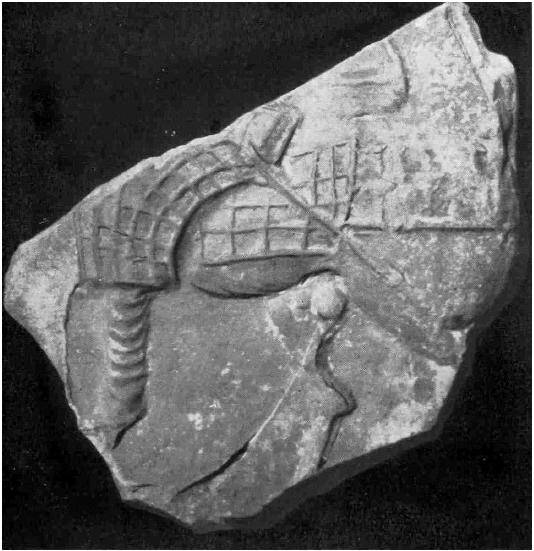
Pottery from Humbuz Tepe. IV-III centuries BC e. The image is based on the article by S. Ivanov "On the issue of heavy cavalry in ancient Central Asia based on the ostracon from Humbuz-Tepe"
In addition to the find from Humbuz-Tepe, the remains of armor from Chirik-Rabat (Kazakhstan) should be noted. This composite developed iron armor of the 2th or late 1962th - early XNUMXrd centuries. BC BC, in addition to small plates with a thickness of at least XNUMX mm, it has narrow stripes, which obviously constituted the laminar protection of the limbs. Tolstov assumed that the longest of these stripes protected the lower part of the warrior's body in the manner of the Roman lorica segmentata. Unfortunately, researchers practically do not work with this remarkable find, but only refer to the work of Tolstov in XNUMX ...
Alas, Olbricht's hypothesis does not explain what happened to the cataphracts throughout the XNUMXrd century BC. e., when they seemed to have dropped out of sight. We know about the Iranian contingents of that time in the armies of the Diadochi, but it does not follow from anywhere that they were precisely cataphracts.
Only in 201 BC. e. cataphracts appear under their historical name in Polybius when describing the battle of Panion in the army of the Seleucid king Antiochus III. Since this war was preceded by the eastern campaign of Antiochus in Parthia and Bactria, some historians, starting with Tarn, attributed Parthian origins to this cavalry.
In 190 BC. BC under Magnesia, Antiochus possessed 6000 cataphracts, which, according to Libya, were at least partially "Median", that is, Iranian origin. It remains to be wondered whether this was a consequence of the military-technical impulse of the XNUMXth century described above. BC e.? Having identified the initial carriers of the new technology - the Sakas and their neighbors, including, possibly, the Bactrians, it is not surprising that it began to spread among the Iranian nomadic tribes, first of all, related to the Sakas. However, such a hundred-year delay looks strange and is only partly explained by the lack of sources.
The existence of cataphracts in the XNUMXnd century BC e., and from the very beginning, there is no doubt. In addition to written evidence, this is evidenced by archaeological finds. For example, items of equipment from the "arsenal" in Ai-Khanum (Greco-Bactrian kingdom), which have an appearance very close to the later forms, which indicates their technical "maturity" and thoughtfulness. At this time, cataphracts suddenly appear as an established branch of the army over a vast territory, which makes it extremely difficult to determine the source of their origin.
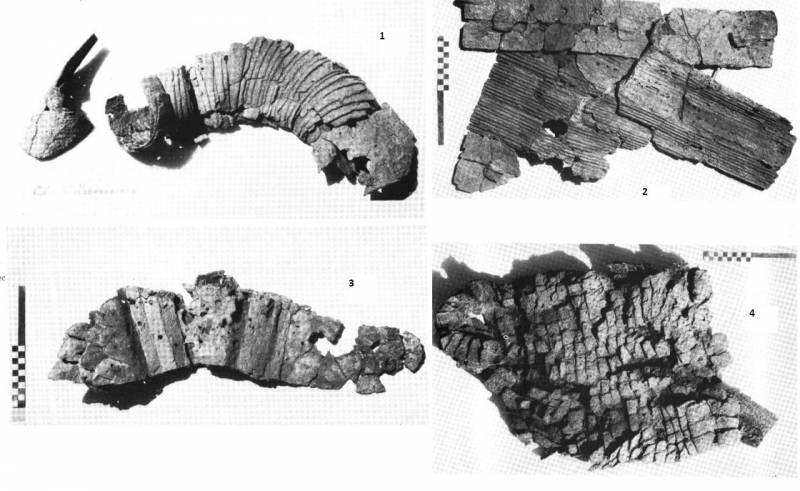
Cataphract equipment from Ai-Khanum (Afghanistan). 1 - leg protection (?), 2 - legguard, 3 - shoulder pad, 4 - bib. Cited after Garczynski P. Guillaume O. etc, Campagne de fouille, 1978 à Aï Khanoum (Afghanistan)
Scythian (Scythian-Sarmatian) alternative
Having analyzed Olbricht's hypothesis, let's move from Central Asia to the Black Sea steppes to the European Scythians.
The popular belief about the light Scythian cavalry, who defeated enemies by starvation, has long been refuted as half-hearted. It is now generally accepted that the Scythians, at least by the IV century. BC e. combined horse archers and armed horsemen, striving for a decisive hand-to-hand combat. It seems reasonable to take the next step and check the Scythians of that time for compliance with the criteria for cataphracts.
We know that the amount of armor remains found in Scythian burials is very large. Gulaev states that every fifth Scythian buried in the Middle Don graves wore armor. The researcher reasonably believes that this proportion significantly exceeds the number of aristocrats and testifies to the spread of armor among some of the vigilantes.
Regarding the long spears, the analysis was made by the famous Scythian specialist Chernenko:
There remained the third criterion - the presence of whole detachments of heavily armed horsemen among the Scythians. The battle of Fat, which took place in 310-309 BC, sheds light. e. and described by Diodorus of Siculus. According to his description, the contender for the Bosporan throne, Satyr, stood at the head of the center of the battle order, leading the allies of the Scythians, and won, thanks to a decisive horse attack. Thus, by indirect signs, one can assume the presence of orders of cataphracts.
Unfortunately, the appearance of these Scythian armored horsemen has to be reconstructed from many separate fragmentary finds. On the other hand, in the neighboring, Savromatsk (early Sarmatian) area, separate time-synchronous finds give a much more complete picture.
In 2000-2009, near the village. Filippovka, Orenburg region, excavations of burial mounds took place. Burial ground Filippovka 1 turned out to be so rich that it received the code name "royal", by analogy with the famous Scythian. Some of the finds have Scythian counterparts. One of the researchers, L. T. Yablonsky, directly points to the Scythian parallels.
The spearheads are massive, leaf-shaped. A spear from mound 4 is placed along the body of the buried. Although the shaft has not survived, due to the presence of an inlet (a forging at the rear end of the spear), it is possible to accurately determine its length - 3,2 meters. Quite a contos cataphract.
Of exceptional interest is the helmet from mound 11. Forged, iron, it is a local imitation of the Greek Chalcidian forms. Moreover, he has no direct analogies at all.
The armor is scaly, iron. The upper edge of the plates was attached on an organic basis. Bone armor was found in mound 29. Its plates were attached to the base with both the upper and lower parts.
The rest of the weaponry is represented by bows, daggers and a pick in poor condition.
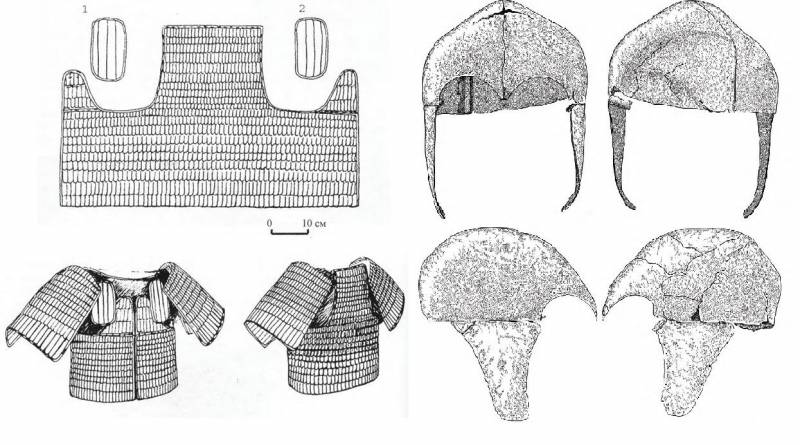
Iron armor and iron helmet from the Filippovka burial mounds 1. End of the XNUMXth - third quarter of the XNUMXth centuries. BC e. Cited by Yablonsky L. T. Early Sarmatian knight.
Even the upper dating of the burials falls on the last quarter of the XNUMXth century BC. e. That is, almost simultaneously with Alexander's campaign to the East.
Does all this mean that those buried in the mounds are the first reliably known cataphracts?
We cannot yet speak of this with certainty. No traces of horse protection were found in the burial. It was generally not typical for the early Sarmatians, as far as can be judged from the data of archeology. But, according to Khazanov, this is not an obligatory criterion for being considered a cataphract. The Filippovka 1 burial ground is unique for the Savromat world and cannot serve as a typical example. Nevertheless, the discovery of armed horsemen with Scythian influence in the area adjacent to the Scythians may serve as additional evidence in favor of the fact that Scythia was a possible center for the origin of cataphracts. But again, as in the case of Olbricht's hypothesis, we are faced with a lack of direct information about cataphracts in the XNUMXrd century. BC e., which does not allow building a logical chain to the information we know about cataphracts of the XNUMXnd century. BC e.
Conclusions
Although the first direct mention of cataphracts dates back to 200 BC, the available data allow us to speak with a certain degree of certainty about cataphracts from the XNUMXth century. BC e. Perhaps the first such cavalry were received by the Eastern Scythians - the Saks and their neighbors, and, possibly, the European Scythians. Unfortunately, there is a gap in the sources of about a hundred years, during which it is almost impossible to track the development of the phenomenon. This undoubtedly diminishes the value of the argument about the antiquity of the cataphracts. In the II century BC. e. the presence of cataphracts is already quite obvious, and they operate on vast expanses from Afghanistan to Syria.
The next article will consider in more detail the characteristic technical points that determine the appearance of this type of cavalry: saddles, spear length, ramming technique and its effectiveness.
Sources:
Gulyaev. VI Scythians: the rise and fall of the great kingdom. 2006
Ivanov S. S. On the issue of heavy cavalry in ancient Central Asia based on the ostracon from Humbuz-Tepe.
Nikonorov V. P. "Cataphracts" or "Cataphracts". Once again, regarding the two designations of the antique armored cavalry. 2007
Olbricht M. Ya. On the origin of the cataphract cavalry in Iran and Central Asia. 2010
Tolstov S.P. Along the ancient deltas of the Oxus and Yaksart. 1962
Khazanov A.M. Essays on military affairs of the Sarmatians. 1971
Chernenko E.V. Long spears of the Scythians. 1984
Chernenko E. V. About the time and place of the appearance of heavy cavalry in the steppes of Eurasia. 1971
Yablonsky L. T. Early Sarmatian knight. 2013
Garczynski P. Guillaume O. etc. Campagne de fouille 1978 à Aï Khanoum (Afghanistan). 1978
Mielkzarek M. Cataphracts-a Parthian element in the Seleucid art of war. 1996
Nikonorov, V., Cataphracti, CataFractarii and Clibanarii: Another Look At The Old Problem of their Identifications. 1998.
Potts, DT, Cataphractus and kamandar: Some thoughts on the dynamic evolution of heavy cavalry and mounted archers in Iran and Central Asia. 2007
Sevinç N., Körpe R., Tombul M. etc. (2001). A Newpainted Graco-Persian Sarcophagus from çan.
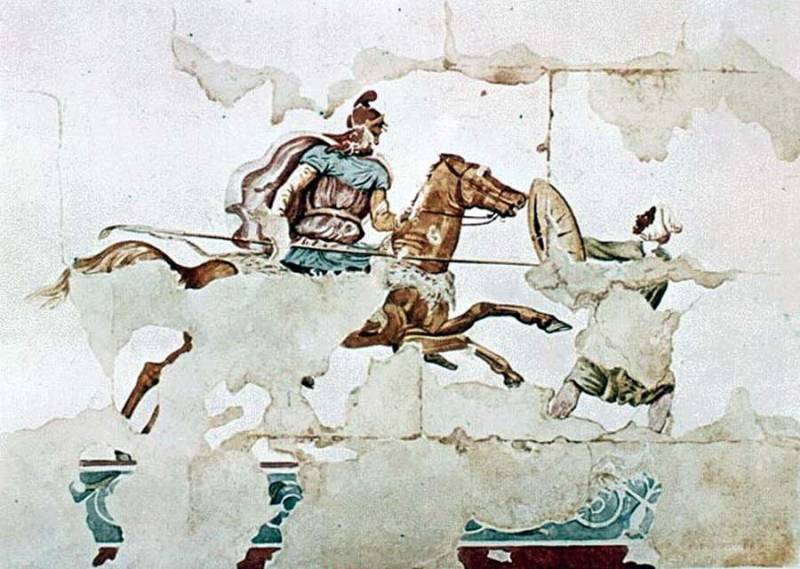
Information